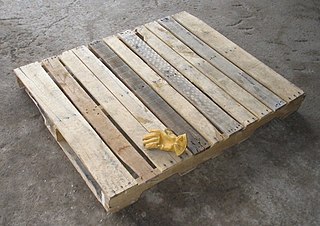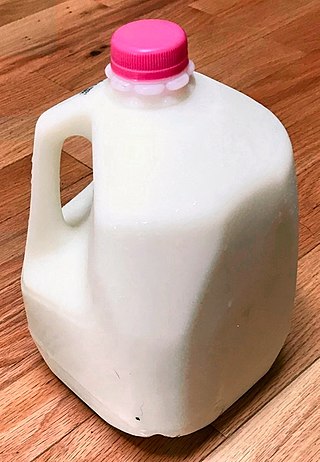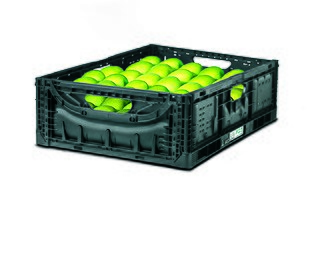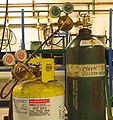
A reusable bottle is a bottle that can be reused, as in the case as by the original bottler or by end-use consumers. Reusable bottles have grown in popularity by consumers for both environmental and health safety reasons. Reusable bottles are one example of reusable packaging.

Packaging is the science, art and technology of enclosing or protecting products for distribution, storage, sale, and use. Packaging also refers to the process of designing, evaluating, and producing packages. Packaging can be described as a coordinated system of preparing goods for transport, warehousing, logistics, sale, and end use. Packaging contains, protects, preserves, transports, informs, and sells. In many countries it is fully integrated into government, business, institutional, industrial, and for personal use.

A drum is a cylindrical shipping container used for shipping bulk cargo. Drums can be made of steel, dense paperboard, or plastic, and are generally used for the transportation and storage of liquids and powders. Drums are often stackable, and have dimensions designed for efficient warehouse and logistics use. This type of packaging is frequently certified for transporting dangerous goods. Proper shipment requires the drum to comply with all applicable regulations.

A pallet is a flat transport structure, which supports goods in a stable fashion while being lifted by a forklift, a pallet jack, a front loader, a jacking device, or an erect crane. Many pallets can handle a load of 1,000 kg (2,200 lb). While most pallets are wooden, pallets can also be made of plastic, metal, paper, and recycled materials.

A crate is a large shipping container, often made of wood, typically used to transport or store large, heavy items. Steel and aluminium crates are also used. Specialized crates were designed for specific products, and were often made to be reusable, such as the "bottle crates" for milk and soft drinks.

A Slip sheet is “a corrugated, solid fiber, or plastic sheet onto which a unit load can be assembled. A protruding short panel can be grasped by the jaws of a pull-pack truck and the load pulled back onto the pull-pack platform.”

Glass milk bottles are glass bottles used for milk. They are reusable and returnable – used mainly for doorstep delivery of fresh milk by milkmen. Once customers have finished the milk, empty bottles are expected to be rinsed and left on the doorstep for collection, or rinsed bottles may be returned to a participating retail store. Bottle sizes vary depending on region, but common sizes include pint, quart or litre.

Intermediate bulk containers are industrial-grade containers engineered for the mass handling, transport, and storage of liquids, semi-solids, pastes, or solids. The two main categories of IBC tanks are flexible IBCs and rigid IBCs. Many IBCs are reused or repurposed.

Plastic milk containers are plastic containers for storing, shipping and dispensing milk. Plastic bottles, sometimes called jugs, have largely replaced glass bottles for home consumption. Glass milk bottles have traditionally been reusable while light-weight plastic bottles are designed for single trips and plastic recycling.

Reuse is the action or practice of using an item, whether for its original purpose or to fulfill a different function. It should be distinguished from recycling, which is the breaking down of used items to make raw materials for the manufacture of new products. Reuse—by taking, but not reprocessing, previously used items—helps save time, money, energy and resources. In broader economic terms, it can make quality products available to people and organizations with limited means, while generating jobs and business activity that contribute to the economy.

A bulk box, also known as a bulk bin, skid box, pallet box, bin box, gaylord, or octabin, is a pallet-size box used for storage and shipping of bulk or packaged goods. Bulk boxes can be designed to hold many different types of items such as plastic pellets, watermelons, electronic components, and even liquids; some bulk boxes are stackable.
Insulated shipping containers are a type of packaging used to ship temperature sensitive products such as foods, pharmaceuticals, organs, blood, biologic materials, vaccines and chemicals. They are used as part of a cold chain to help maintain product freshness and efficacy. The term can also refer to insulated intermodal containers or insulated swap bodies.

The term unit load refers to the size of an assemblage into which a number of individual items are combined for ease of storage and handling, for example a pallet load represents a unit load which can be moved easily with a pallet jack or forklift truck, or a container load represents a unit for shipping purposes. A unit load can be packed tightly into a warehouse rack, intermodal container, truck or boxcars, yet can be easily broken apart at a distribution point, usually a distribution center, wholesaler, or retail store for sale to consumers or for use.

The square milk jug is a variant of the one-gallon (3.785-liter) plastic milk container sold in the United States. The design was introduced in the summer of 2008 and is marketed as environmentally friendly because of the shape's advantages for shipping and storage.
A shipping container is a container with strength suitable to withstand shipment, storage, and handling. Shipping containers range from large reusable steel boxes used for intermodal shipments to the ubiquitous corrugated boxes. In the context of international shipping trade, "container" or "shipping container" is virtually synonymous with "intermodal freight container", a container designed to be moved from one mode of transport to another without unloading and reloading.
Bottles are able to be recycled and this is generally a positive option. Bottles are collected via kerbside collection or returned using a bottle deposit system. Currently just over half of plastic bottles are recycled globally. About 1 million plastic bottles are bought around the world every minute and only about 50% are recycled.

IFCO trays are a type of reusable packaging for transporting fresh food produce. IFCO SYSTEMS is the name of the company that first developed a pooling service for reusable plastic trays for fresh produce in 1992, when the company was founded in Pullach, Germany. IFCO is the acronym for International Food Container Organization.

Package handles, or carriers, are used to help people use packaging. They are designed to simplify and to improve the ergonomics of lifting and carrying packages. Handles on consumer packages add convenience and help facilitate use and pouring. The effect of handles on package material costs and the packaging line efficiencies are also critical. A handle can be defined as “an accessory attached to a container or part for the purpose of holding or carrying.” Sometimes a handle can be used to hang a package for dispensing or use.

Packaging waste, the part of the waste that consists of packaging and packaging material, is a major part of the total global waste, and the major part of the packaging waste consists of single-use plastic food packaging, a hallmark of throwaway culture. Notable examples for which the need for regulation was recognized early, are "containers of liquids for human consumption", i.e. plastic bottles and the like. In Europe, the Germans top the list of packaging waste producers with more than 220 kilos of packaging per capita.

Closed Loop Box Reuse, is the process by which boxes or other containers are reused many times. It is a form of reusable packaging.












































